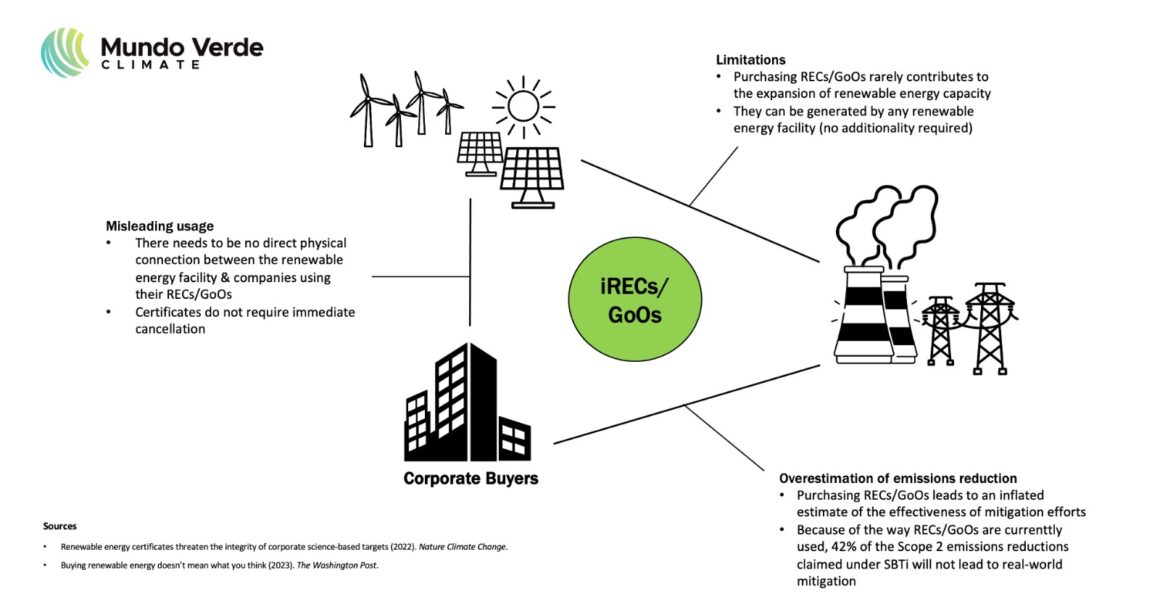Under the Greenhouse Gas (GHG) Protocol, many companies and organizations utilize renewable energy certificates (RECs) to align with their science-based emission reduction targets and claim reductions in Scope 2 emissions (purchased electricity). However, it is essential to understand that purchasing RECs generally do not contribute to the creation of additional clean energy generation capacity. This is because RECs may be generated by existing renewable energy power facilities that received government subsidies or were constructed prior to the REC purchase. In these primary scenarios, purchasing RECs does nothing to help the expansion of renewable energy capacity.
In an article, the Washington Post explains how a wind farm can sell the environmental attributes or “greenness” of its power to other companies in the form of credits. It makes no difference, however, if the purchasing company is located thousands of miles away and draws its electricity from a grid that primarily relies on fossil fuels. The same principle applies to Guarantees of Origin (GoOs), which are the European equivalent of RECs. It is crucial to understand that there needs to be no direct physical connection between the consumers of GoOs or RECs and the renewable energy generation source that sells them, nor do these certificates require immediate cancellation at the moment they are generated. This flexibility allows for companies to cancel their RECs or GoOs at a different time and location from where they were originally generated.
This misleading system has contributed to an overestimation of efforts to address Scope 2 emissions. In June 2022, Nature Climate Change explained how, under the current framework for RECs and GoOs, approximately 42 percent of the claimed reductions in Scope 2 emissions will not result in tangible real-world emissions mitigation. Actual and meaningful mitigation efforts involve transitioning to renewable energy sources, implementing energy efficiency measures to decrease overall electricity consumption, and establishing Power Purchase Agreements (PPAs) with
renewable energy providers. For the residual and hard-to-abate emissions, high-quality carbon offsets from GHG reduction or removal projects can be purchased. Even though this method is difficult and more costly, it provides a genuine solution to the problem.
Essentially, the flexible use of GoOs and RECs can lead to greenwashing, a practice described by the Carbon Disclosure Project as “falsely promoting an organization’s environmental efforts, or spending more resources to promote the organization as green than are spent to actually engage in environmentally sound practices”. Recently, some e-mobility charging stations have started offering RECs to customers as a means of offsetting their Scope 3 emissions. However, RECs are specifically generated to address Scope 2 emissions and serve this purpose exclusively. Offsetting hard-to-abate Scope 3 emissions, on the other hand, requires the use of carbon reduction and removal credits.
Determining the path your organization will take towards achieving a net-zero future requires careful consideration and professional advice. Mundo Verde Climate is available to assist you in identifying apt solutions for your sustainability needs.
Sources
Bjørn, A., Lloyd, S. M., Brander, M., & Matthews, H. D. (2022). Renewable energy certificates threaten the integrity of corporate science-based targets. Nature Climate Change, 12(6), 539–546. doi:10.1038/s41558-022-01379-5
Osaka, S., & Haymond, H. (2023). Retrieved from https://www.washingtonpost.com/climate-environment/2023/06/21/renewable-energy-credits-certificates-greenwashing/

